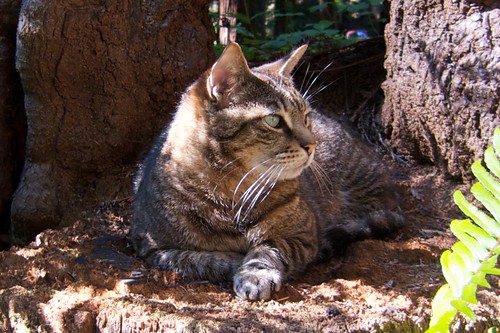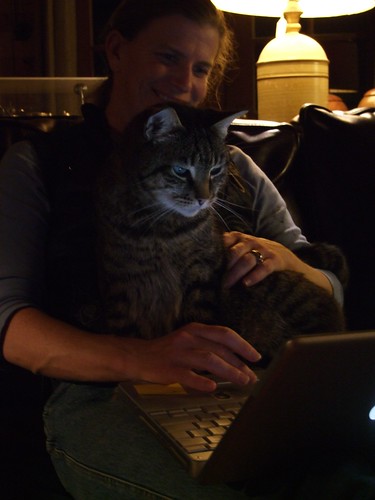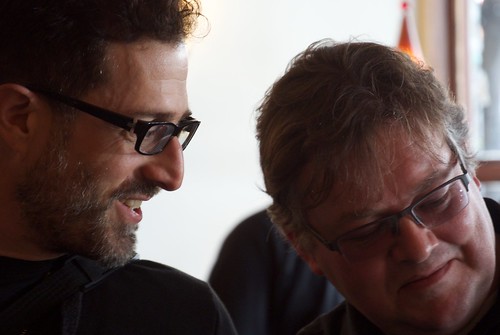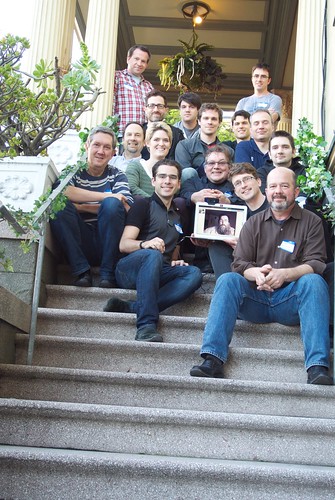Almost two weeks ago, Miles disappeared. Each day that goes by, we lose a little bit of hope that he’s going to stroll in and squawk at us until we shake his food dispenser for him.
Miles was ageless at 15 years old. Although Joell said she’d like to think he just walked off into the forest and lay down to die peacefully in a sunbeam, it’s more likely that something got him. Maybe a dog, but more likely one of the wild animals here in our forest — a bobcat or mountain lion, or maybe an owl or a fox.

I called Miles “The Big Man.” He was a burly cat. He wasn’t one of those fat cats, or something oversized and slow like a maine coon. He was just a regular sized tabby, but when you picked him up he was dense and muscular. He was a handsome guy. He was cool and calm. A man’s cat.
When I got Miles from the pound, he was a stray kitten that the folks at the Humane Society of Santa Clara had named Ringo. I liked the idea of naming him after a musician, but he just wasn’t a Ringo.
My housemate Stephan and I both noticed that this kitten liked it when I played guitar. He would sit close and stare at me while I played. He’d come from across the house to listen.
My other kitten, Yoda, was much more interactive. He’d climb and jump everywhere, and play with your pant leg, or chase flies in the window. Yoda could dead-point the top of the door from a squat and pull himself to the top. The two got along but they were very different.
Miles was aloof for sure. Unless you were playing music, Miles mostly ignored you. He was a small buddha — like one of those kids that people call “an old soul”. He was observant and calm, and sometimes even snuggly. He would often pick out the person in a party who least liked cats and go sit on them, looking away from them at the rest of the room in a sphynx pose with a little cat smile. But he also had this other look. When directed at you, it seemed like he was deeply annoyed with everything, especially you. Stephan and I thought this was hilarious.
We were in the car one weekend, going somewhere, it doesn’t matter where, when it clicked. This kitten wasn’t Ringo. He was Miles. It was that look of disdain that made the name perfect.
Miles and Yoda were as different as two cats could be. But they were “brothers”, and even though Yoda was from fancy-cat parents (Ocicat/Bengal) and Miles was a tabby from the pound, both were gorgeous animals. Yoda is lithe and talkative and active, and Miles was stoic and cool and burly.
When Joell and I got our hound Cissy, we knew she had been around barn cats, so we were sure she was cat-broke. But the boys were not so dog-broke. They really didn’t trust this big hound, and her loud baying freaked them out.
Miles was the first to adjust. If Cissy bayed at the raccoons outside, Miles would twitch his ears and look annoyed. Yoda would dash for a high perch.
When we moved to our little place in the woods in Pescadero, Miles found home. He loved his yard and the woods around us. He hunted. He lay in the sun on the redwood duff, or curled up on his favorite tree stump “throne”. As always, he loved when I played guitar and was patient with me as I tried to re-learn the piano.
The computer fascinated him, especially when Joell would sit in the big brown chair and write, or when I would sit at the big screen and work with him in my lap. He loved stuff that moved — not action-packed video games, but little stuff: my twitter feed, editing a document, administering a website, writing and photo editing.

For years now, each night Cissy the hound jumps up in our bed and Yoda stomps across our chests and meows at us and grunts. But sometimes, Miles would curl up quietly against my back or above our pillows and purr. You couldn’t help but feel like you were somebody special when he would snuggle in.
Four pets is a lot in a tiny house like ours. But we all feel Miles’ absence – especially Yoda. He’s been ever-present and needs to be constantly touching one of us. But even the hounds know something is wrong; someone is missing. Cissy has been especially snuggly and Tucker is laying on my feet as a write.

On a rainy day like today, I find myself looking for him. He should be here, helping me write and warming the whole room.
Miles was my friend. I love him and I miss him deeply.





